
The NSU Prinz (Prince) is an automobile which was produced in West Germany by the NSU Motorenwerke AG from 1958 to 1973.

The NSU Prinz (Prince) is an automobile which was produced in West Germany by the NSU Motorenwerke AG from 1958 to 1973.
| NSU Prinz I, II & III | |
|---|---|
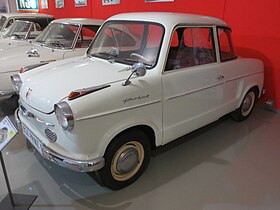 NSU Prinz I | |
| Overview | |
| Production | 1958–1962 |
| Assembly |
|
| Body and chassis | |
| Body style | 2-door saloon [2] |
| Related |
|
| Powertrain | |
| Engine | 583 cc (35.6 cu in) I2 [2] rear-mounted air-cooled |
| Transmission | 4-speed manual 4-speed manual all-synchromesh [2] |
| Dimensions | |
| Wheelbase | 78.7 in (2,000 mm) |
| Length | 124 in (3,150 mm) [2] |
| Width | 56 in (1,422 mm) [2] |
| Height | 53 in (1,346 mm) [2] |
The first post-war NSU car, the Prinz I, was launched at the Frankfurt Motor Show in September 1957 accompanied by the advertising slogan "Fahre Prinz und Du bist König" ("Drive a Prince and you're a king"). [4] After a pilot run of 150 preproduction cars, volume production began in March 1958. [5]
The Prinz I was available as a 2-door saloon [6] featuring an upright roof line and seating for four people. The doors opened wide enough to permit reasonable access even to the rear seats, although leg room was severely restricted if attempting to accommodate four full sized adults. [2] In addition to a luggage compartment accessed via a hatch at the front of the car and shared with the spare wheel and fuel filler, there was a narrow but deep full width space behind the rear seat sufficient to accommodate a holiday suitcase. [2]
The noisy [2] two-cylinder 600 cc 20 PS (15 kW; 20 hp) engine was located at the back where it drove the rear wheels, initially via a "crash" gearbox. Later versions gained a four-speed all-synchromesh gearbox. Contemporaries were impressed by the brevity of the maintenance schedule, with the engine, gear box and final drive operating as a single chamber and all lubricated by means of oil, added through a filler in the rocker box cover. [2] There were just two grease nipples requiring attention, positioned on the steering kingpins. [2] The engine was also commended in contemporary reports for its fuel economy and longevity. [2] Although noisy, the engine offered impressive flexibility, recalling NSU's strengths as a motorcycle manufacturer. [2]
The Prinz II (a 'luxury' version) [7] was released in 1959 with better trim and an all-synchromesh gearbox. [8] A 30E export version was equipped with a 30 hp engine. [8] The Prinz III was launched in October 1960 [9] featuring a new stabilizer bar and the 30 hp motor. [8]
NSU received government approval to build the Prinz in Brazil in the late 1950s, but nothing came of the project. [10]
| NSU Sport Prinz | |
|---|---|
 1964 NSU Sport Prinz | |
| Overview | |
| Production | 1958–1968 [11] 20,831 produced [11] |
| Assembly |
|
| Body and chassis | |
| Body style | 2-door coupé |
| Related | NSU Spider |
| Powertrain | |
| Engine | 583 cc I2 [11] 598 cc I2 [11] |
| Chronology | |
| Successor | Audi TT |
The Sport Prinz was a 2-seater sports coupe variant. [11] It was designed by Franco Scaglione at Bertone studios in Turin. 20,831 were manufactured between 1958 and 1968. [11] The first 250 bodies were built by Bertone in Turin. The rest were built in Heilbronn at Karrosseriewerke Drauz which was later bought by NSU.
The Sport Prinz was initially powered by the 583 cc (35.6 cu in) Prinz 50 straight-twin engine but a maximum speed of 160 km/h (99 mph) was nevertheless claimed. From late 1962 a 598 cc (36.5 cu in) engine was fitted. [11]
The NSU Spider was a Wankel rotary powered two-seater roadster based on the Sport Prinz platform. [11]

| NSU Prinz 4 | |
|---|---|
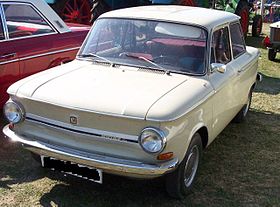 | |
| Overview | |
| Also called | Ramses II (ET) NSU P-1000 (URU, 1963–1964) |
| Production | 1961–1973 |
| Body and chassis | |
| Body style | 2-door saloon [12] |
| Related | NSU P6 (Uruguay, 1963–1967) |
| Powertrain | |
| Engine | 598 cc air-cooled OHV I2 [12] |
| Transmission | 4-speed manual all-synchromesh [12] |
| Dimensions | |
| Wheelbase | 2,040 mm (80.3 in) [13] |
| Length | 3,440 mm (135 in) [13] |
| Width | 1,490 mm (58.7 in) [13] |
| Height | 1,360 mm (53.5 in) [13] |
| Chronology | |
| Successor | Audi 50 |
One of the revelations of the Frankfurt Motor Show in September 1961, [14] [15] the Prinz 4 replaced the original Prinz. Its new body closely resembled the then fashionable Chevrolet Corvair, but was of course much smaller. Like the original Prinz, it was powered by a two-cylinder air-cooled engine in the rear. The Prinz 4 was much improved and continued to be a well-engineered car, like its predecessors. The engine carried on the NSU tradition of an eccentric rod-driven camshaft inherited from their motorcycle engines, and had a dynastart (combined starter/generator) built into the crankcase. The dynastart also works as a flywheel of the engine. Later, four-cylinder engines adopted the more conventional (pre-engaged) separate starter motor and alternator.
In 1968, Britain's Autocar road tested a Super Prinz. They had tested a Prinz 4 in 1962, and in commenting on how little the car had changed in the intervening six years quipped some of their road testers appeared to have gained more weight than the commendably light-weight Prinz in that period. [12] The test car achieved a top speed of 70 mph (113 km/h) and accelerated to 60 mph (97 km/h) in 35.7 seconds. [12] The home grown Mini 850 only reached 60 mph in 29.5 seconds in an equivalent contemporary test and also managed to beat the NSU's top speed, albeit only by about 3%. [12] At this time, the UK car market was heavily protected by tariffs, and the Prinz's UK manufacturer's recommended retail price was £597, which was more than the (possibly below cost)[ citation needed ] £561 asked for the 850 cc Mini, but certainly not completely out of touch with it. [12] The testers concluded their report that the car was competitively priced in its class and performed adequately. [12] They opined, cautiously, it offered 'no more than the rest' but neither did it 'lack anything important'.

| NSU Prinz 1000/1000 C/TT/TTS | |
|---|---|
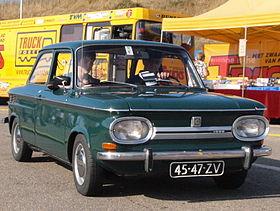 NSU 1000 C | |
| Overview | |
| Production | 1963–1972 |
| Body and chassis | |
| Body style | 2-door saloon |
| Related | NSU P10 (Uruguay, 1970–1971) |
| Powertrain | |
| Engine | |
| Transmission | 4-speed manual all-synchromesh |
| Dimensions | |
| Wheelbase | 2,250 mm (88.6 in) [13] |
| Length |
|
| Width | 1,490 mm (58.7 in) [13] |
| Height | 1,364 mm (53.7 in) [13] |
| Chronology | |
| Successor | Audi 50 |
The NSU Prinz evolved into the somewhat larger bodied NSU Prinz 1000 (Typ 67a), introduced at the 1963 Frankfurt Motor Show. [16] [17] A sporting NSU 1000 TT (with a 1.1 litre engine) also appeared, which was later developed into the NSU (1200) TT [18] and NSU TTS [19] models. All had the same body with inline-four air-cooled OHC engines and were frequently driven as sports cars, but also as economical family cars as well. The mostly alloy engines were very lively, and highly reliable.The OHC arrangement was quite advanced for the time on a small family car as most home-grown cars were still using less efficient pushrod engines. Paired with the low total weight, excellent handling and cornering, both the NSU 1000 and the much higher powered NSU 1200 TT/TTS outperformed many sportscars. The Prinz 1000 lost the "Prinz" part of the name in January 1967, becoming simply the NSU 1000 or 1000 C depending on the equipment. It has 40 PS (29 kW) DIN, while the 1200 TT has 65 PS (48 kW) DIN and the most potent TTS version has 70 PS (51 kW) DIN from only one litre. [13] The 1000 received large oval headlights, while the sportier TT versions have twin round headlights mounted within the same frame. The first 1000 TT has 55 PS (40 kW) DIN and uses the engine first introduced in the larger NSU Typ 110.

The NSU Prinz 1000 TT was built in 14,292 examples between 1965 and 1967, when it was replaced by the bigger engined TT. This, with a 1.2-liter engine, was built until July 1972 for a total of 49,327 examples. The TT can be recognized by its broad black stripe between its headlights. The TTS was built especially for competition, being successful in both hillclimbs and circuit racing. It has a front-mounted oil cooler and was built in 2,402 examples from February 1967 until July 1971. It was briefly referred to as the "Prinz 1000 TTS" when first introduced. There was also a competition model of the TTS available for sale, with 83 PS (61 kW). [16] Production of the Typ 67a (NSU 1000) came to a halt in December 1972.
In 1965, an even larger model was added, initially called Typ 110, and from 1967 on NSU 1200. It offered more space, so it was a better family car, but was not as sporty as the smaller models. Therefore, the NSU 1200TT used the 1200 cc engine of the 1200 in the smaller body of the NSU 1000.

When NSU was acquired by Volkswagen in 1969, it was merged with Auto Union AG. Auto Union had previously been taken over by VW in 1964 and produced mid-sized cars, resurrecting the Audi marque. The name of the new company changed to Audi NSU Auto Union AG. The small, rear-engined NSUs were phased out in 1973, as production capacity was needed for larger and more profitable Audis. The successor of the NSU Prinz was the front-wheel drive Audi 50, later rebadged Volkswagen Polo.
Under license, the Prinz was manufactured in Sarajevo, Yugoslavia, by PRETIS (Preduzeće Tito Sarajevo). Around 15,000 vehicles were made. [20]
The Prinz was also manufactured in Argentina by Autoar, making mainly models Prinz II and Prinz III / 30. A total of 2,432 units were built between 1959 and 1963. It is told[ who? ] only 40-45 Sportprinz and a few Prinz IV (less than 10) were imported.[ citation needed ]
The Ramses was the first car produced in Egypt, and was the result of a co-operation between the new Egyptian car firm Egyptian Light Transport Manufacturing Company, and NSU. The factory was located right next to the Great Pyramids. Plans were to produce around 10,000 cars a year, most of the work being manual labor. [21]
The Prinz 4-cylinder air-cooled engine was also famously adopted by Friedl Münch in 1966 for the hand-built Münch Mammut motorcycle, at the time the fastest and most expensive motorcycle in production.
In Uruguay, the Prinz 4 was built by Nordex S.A., and a new model, the P6, combined the engine and mechanics of the NSU model with a separate body completely redesigned by Carlos Sotomayor. From 1970, the P10 was built as the successor model to the NSU P6. This had the larger engine of the NSU Prince 1000 and a 21 cm extended wheelbase. [22]
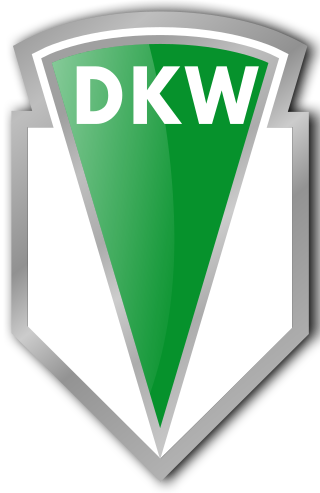
DKW was a German car- and motorcycle-marque. DKW was one of the four companies that formed Auto Union in 1932 and thus became an ancestor of the modern-day Audi company.

The Mercedes-Benz C-Class is a series of compact executive cars produced by Mercedes-Benz Group AG. Introduced in 1993 as a replacement for the 190 (W201) range, the C-Class was the smallest model in the marque's line-up until the W168 A-Class arrived in 1997. The C-Class has been available with a "4MATIC" four-wheel drive option since 2002. The third generation (W204) was launched in 2007 while the current W206 generation was launched in 2021.

Auto Union AG was an amalgamation of four German automobile manufacturers, founded in 1932 and established in 1936 in Chemnitz, Saxony. It is the immediate predecessor of Audi as it is known today.
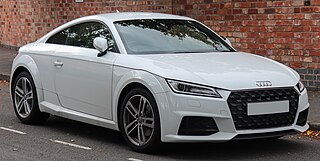
The Audi TT is a production front-engine, 2-door, 2+2 sports coupé and roadster, manufactured and marketed by Audi from 1998 to 2023 across three generations.

The Volkswagen K70 is a four-door, front engine, front wheel drive sedan developed by NSU and marketed from 1970–1975 by Volkswagen after its 1969 acquisition of NSU.

The NSU Ro 80 is a four-door, front-engine executive sedan manufactured and marketed by the West German firm NSU from 1967 until 1977.

NSU Motorenwerke AG, or NSU, was a German manufacturer of automobiles, motorcycles and pedal cycles, founded in 1873. Acquired by Volkswagen Group in 1969, VW merged NSU with Auto Union, creating Audi NSU Auto Union AG, ultimately Audi. The name NSU originated as an abbreviation of "Neckarsulm", the city where NSU was located.

The Mercedes-Benz CLK-Class is a former series of mid-size or entry-level luxury coupés and convertibles produced by Mercedes-Benz between 1996 and 2010. Although its design and styling was derived from the E-Class, the mechanical underpinnings were based on the smaller C-Class, and was positioned between the Mercedes-Benz SLK-Class and CL-Class. The name CLK is either derived from the German words "Coupé", "Luxus" (luxury) and "Kurz" (short) or "Coupé", "Leicht" (light) and "Kurz" (short), as the clear definition was never published. It primarily competes with the two-door BMW 3 and 6 Series, as well as the Audi A4 Cabriolet and Audi A5 Coupe/Cabriolet, as well as the Maserati Coupe and its convertible variant.
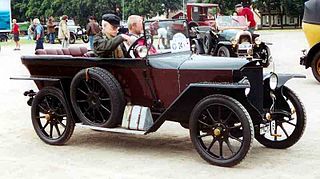
The Aktiengesellschaft für Automobilbau was a German producer of cars in the 1920s in the German capital of Berlin (Prussia).

The Audi 50 is a small supermini car produced by German automaker Audi from 1974 to 1978, and sold only in Europe. Introduced two and three years after the French Renault 5 and the Italian Fiat 127 respectively, the Audi 50 and its VW Polo twin were seen at the time as Germany's first home-grown entrant in Europe's emerging class of "supermini" hatchbacks, supplanting a generation of small and often rear-engined economy cars.

The Mercedes-Benz W123 is a range of executive cars produced by German manufacturer Mercedes-Benz from November 1975 to January 1986. The W123 models surpassed their predecessor, the Mercedes-Benz W114, as the most successful Mercedes, selling 2.7 million units before production ended in the autumn of 1985 for the saloon/sedan versions and January 1986 for coupés and estates/station wagons.

NSU-Fiat was a German automobile manufacturer which produced Fiat vehicles under license at a plant acquired from NSU in Heilbronn from 1929 to 1957.

F103 is the internal designation for a series of car models produced by Auto Union GmbH in West Germany from 1965 to 1972, derived from the earlier DKW F102. To signify the change from a two-stroke to four-stroke engine, the DKW marque was dropped in favour of Audi, a name that had been dormant since before the Second World War.

The NSU Spider is an automobile which was produced by NSU Motorenwerke AG from 1963 to 1967.

The Auto Union 1000 is a luxury compact front-wheel drive automobile manufactured by Auto Union GmbH between 1958 and 1969. It was the first model branded as an Auto Union by the manufacturer since the 1930s; it replaced the DKW 3=6, although the latter continued in production, until the end of 1959. The two cars were broadly similar, but the new car had its two-stroke engine enlarged to 981 cc yielding a 10% - 37% power increase.

The NSU Typ 110 is a small car that was made by NSU between 1965 and 1972. It was first presented at the 1965 Frankfurt Motor Show, widening NSU's range in the process. It was based on the NSU Prinz 1000 but with a longer wheelbase and a front overhang which increased available space both in the passenger cabin and in the luggage compartment. With an external length of four metres the car took NSU into the lower rungs of the middle class saloon sector, as it existed at that time in West Germany. It was to distance the model from the small car sector that for this model NSU abandoned the Prinz name which had till then been carried by their passenger cars.

The Auto Union Grand Prix racing cars types A to D were developed and built by a specialist racing department of Auto Union's Horch works in Zwickau, Germany, between 1933 and 1939, after the company bought a design by Dr. Ferdinand Porsche in 1933. The Auto Union type B streamlined body was designed by Paul Jaray.

The Audi Type P was a small two-door sedan/saloon car introduced by Audi in 1931. It was discontinued by 1932.

The Mercedes-Benz W02 was a midsize six-cylinder two-litre-engined automobile introduced by Daimler-Benz at the Berlin Motor Show in October 1926. It was developed in some haste under the manufacturer's Technical Director, Ferdinand Porsche in parallel with the smaller Mercedes-Benz W 01 and the larger three-litre-engined Mercedes-Benz W03 following the creation of Daimler-Benz, formally in July 1926, from the fusion of the Daimler and Benz & Cie auto-businesses.
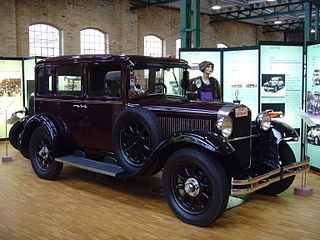
The Mercedes-Benz W11 was a midsize six-cylinder automobile introduced by Daimler-Benz it 1929. It was developed from the Mercedes-Benz W02 first seen in 1926, and the W11 shared its chassis and bodywork with the W02, but the W11 came with a larger more powerful engine, a new name and a wider list of “standard bodies” from which customers could choose.